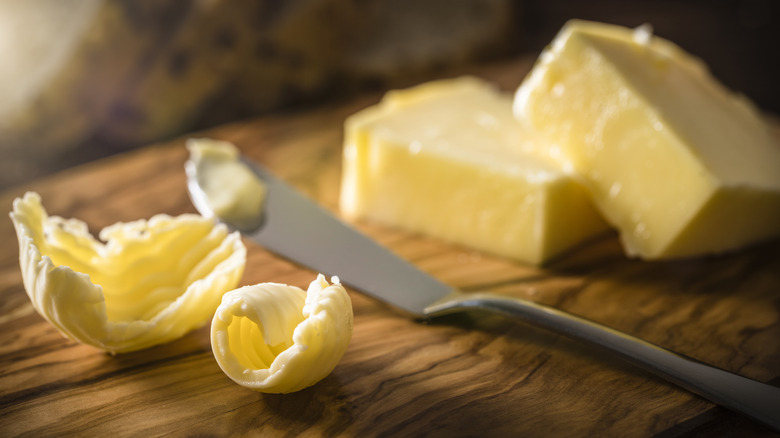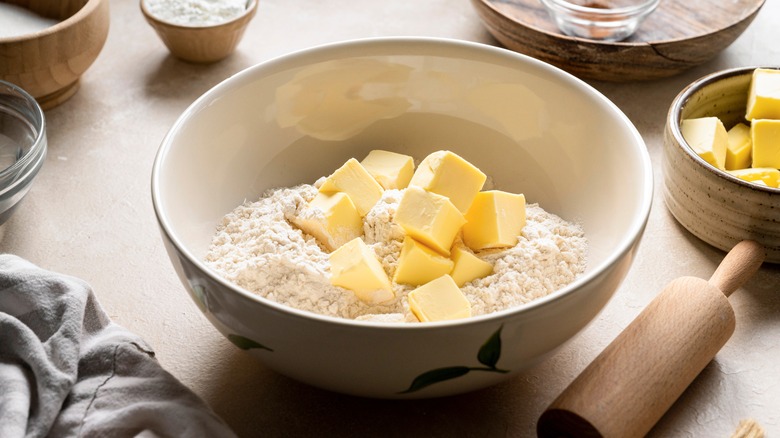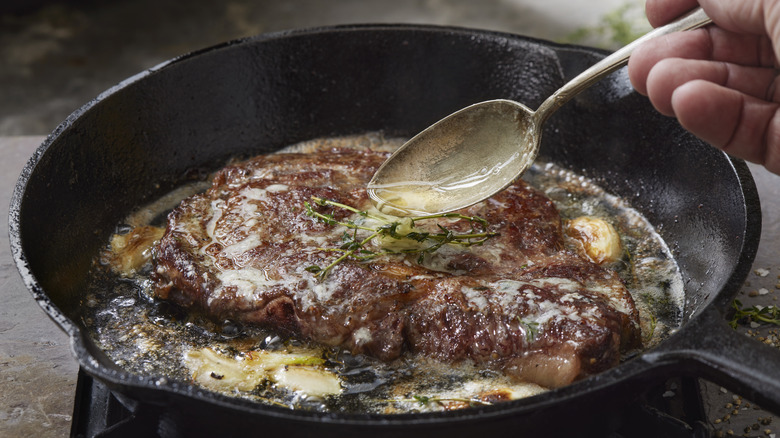What To Keep In Mind When Cooking With Cultured Butter
Cultured butter doesn't have to be reserved for a thick smear of goodness on a fresh baguette with a little flaky salt, even if that may be its purest form. Using cultured butter in your cooking can be an instant upgrade — or a big, disappointing waste of money. To properly harness the rich, creamy depth of complex flavor, there are a few things to keep in mind.
The first is to find the right applications for it. Cultured butter can be pricey. Maybe you have that casual cultured butter money, in which case you should use it to your heart's content. If not, it's worth finding the perfect recipes in which you can taste the slight tang of the cultures. That means finding recipes where butter is the star.
Cultured butter shines in butter-forward dishes like shortbread or Italian butter cookies, butter biscuits, beurre blanc, butter-glazed vegetables like carrots or green beans, pound or butter cake, seafood in a butter sauce, pasta in a butter sauce (really anything in a butter sauce), an all-butter pie crust, and mashed potatoes, just to list a few dreamy, buttery options. You can even put butter in ramen broth for kicked-up noodle soup. Sure, you can use a couple of tablespoons of it in anything that calls for butter, but the flavor can get lost.
Cultured butter provides a difference in texture
If you're already regularly using European or European-style butter like Plugra or Kerrygold, you might not notice a difference in the texture, richness, or structure of your normal recipes when using cultured butter. If you use a typical American grocery store butter like Land O'Lakes, though, there's a good chance that your dishes will be noticeably different if you switch to cultured butter. This is because most cultured butter has a higher butterfat percentage that's closer to or equivalent to European butter.
In the U.S., butter has to contain at least 80% milk fat (per USDA). In Europe, though, butter has a higher percentage of milkfat — often 82% or higher (even though EU law also requires 80%, per Eur-Lex). Even a difference of 2% can make a difference in the richness and creaminess of your dish — or the structure of it.
Butter with higher fat percentages in the 85% range can actually lead to baked goods being dense rather than light and airy. The moisture level in butter can make or break the leavening in cakes and the flakiness in pie doughs because the water content will turn into steam and lift the crumb. Most recipes are designed to use more standard ingredients unless otherwise noted, so super-premium butter will change them.
Low moisture makes a difference in cooking, too
Lower moisture might spell trouble for certain baking applications, but it can mean great things for cooking at higher heat. Because there's less moisture, the smoke point is higher. This makes it a better choice for searing meat or finishing steak.
To clarify a point about butter smoke points: Of all the different types of butter, cultured butter does not have the highest smoke point. That honor goes to clarified butter. The presence of milk solids in cultured butter still has the potential to burn and smoke, so it's not great for high-heat frying.
The lower moisture content and presence of milk solids (not to mention how delicious it is) do make it ideal for browning. Butter doesn't start browning until the water is gone. With less water, cultured butter browns just a little faster than regular sweet cream butter. As always when browning butter, watch the pan closely once it stops sputtering to keep it from burning. With its special place in a kitchen and higher price point, burning cultured butter is even more sad than usual.


